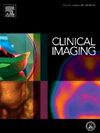Diffuse unilateral MRI breast entities
IF 1.8
4区 医学
Q3 RADIOLOGY, NUCLEAR MEDICINE & MEDICAL IMAGING
引用次数: 0
Abstract
Many benign and malignant breast entities can present with diffuse unilateral magnetic resonance imaging (MRI) findings. The unilateral breast findings can be broken down into three broad categories including asymmetric diffuse masses/non-mass enhancement (NME), diffuse unilateral skin thickening, and diffuse asymmetric background enhancement. Although correlation with clinical history is always necessary, biopsy is often needed to make a definitive diagnosis. There are some findings on MRI which can help narrow the differential including morphology, distribution, T2W signal, enhancement kinetics, and associated skin thickening. Malignant entities which will be discussed in this review include ductal carcinoma in situ, invasive ductal carcinoma, invasive lobular carcinoma, Paget disease, inflammatory breast cancer, and locally advanced breast cancer. Benign entities which will be discussed in this review include idiopathic granulomatous mastitis (IGM), infectious mastitis, pseudoangiomatous stromal hyperplasia, giant fibroadenoma, early and late radiation changes, unilateral breast feeding, and central venous obstruction, all which have varied MRI appearances. It is important for radiologists to be familiar with the common entities that can present with diffuse asymmetric unilateral MRI breast findings to ensure the correct diagnosis and management is undertaken.
弥漫性单侧 MRI 乳房实体。
许多良性和恶性乳腺实体都可能出现弥漫性单侧磁共振成像(MRI)结果。单侧乳腺检查结果可分为三大类,包括不对称弥漫性肿块/非肿块增强(NME)、弥漫性单侧皮肤增厚和弥漫性不对称背景增强。虽然与临床病史相关总是必要的,但通常需要进行活检才能做出明确诊断。核磁共振成像上的一些发现有助于缩小鉴别范围,包括形态、分布、T2W 信号、增强动力学和相关的皮肤增厚。本综述将讨论的恶性实体包括导管原位癌、浸润性导管癌、浸润性小叶癌、Paget 病、炎症性乳腺癌和局部晚期乳腺癌。本综述将讨论的良性病变包括特发性肉芽肿性乳腺炎(IGM)、感染性乳腺炎、假性血管瘤基质增生、巨大纤维腺瘤、早期和晚期放射改变、单侧乳房喂养和中心静脉阻塞,所有这些病变都有不同的磁共振成像表现。放射科医生必须熟悉可能出现弥漫性非对称单侧 MRI 乳房检查结果的常见实体,以确保进行正确的诊断和处理。
本文章由计算机程序翻译,如有差异,请以英文原文为准。
求助全文
约1分钟内获得全文
求助全文
来源期刊

Clinical Imaging
医学-核医学
CiteScore
4.60
自引率
0.00%
发文量
265
审稿时长
35 days
期刊介绍:
The mission of Clinical Imaging is to publish, in a timely manner, the very best radiology research from the United States and around the world with special attention to the impact of medical imaging on patient care. The journal''s publications cover all imaging modalities, radiology issues related to patients, policy and practice improvements, and clinically-oriented imaging physics and informatics. The journal is a valuable resource for practicing radiologists, radiologists-in-training and other clinicians with an interest in imaging. Papers are carefully peer-reviewed and selected by our experienced subject editors who are leading experts spanning the range of imaging sub-specialties, which include:
-Body Imaging-
Breast Imaging-
Cardiothoracic Imaging-
Imaging Physics and Informatics-
Molecular Imaging and Nuclear Medicine-
Musculoskeletal and Emergency Imaging-
Neuroradiology-
Practice, Policy & Education-
Pediatric Imaging-
Vascular and Interventional Radiology
 求助内容:
求助内容: 应助结果提醒方式:
应助结果提醒方式:


